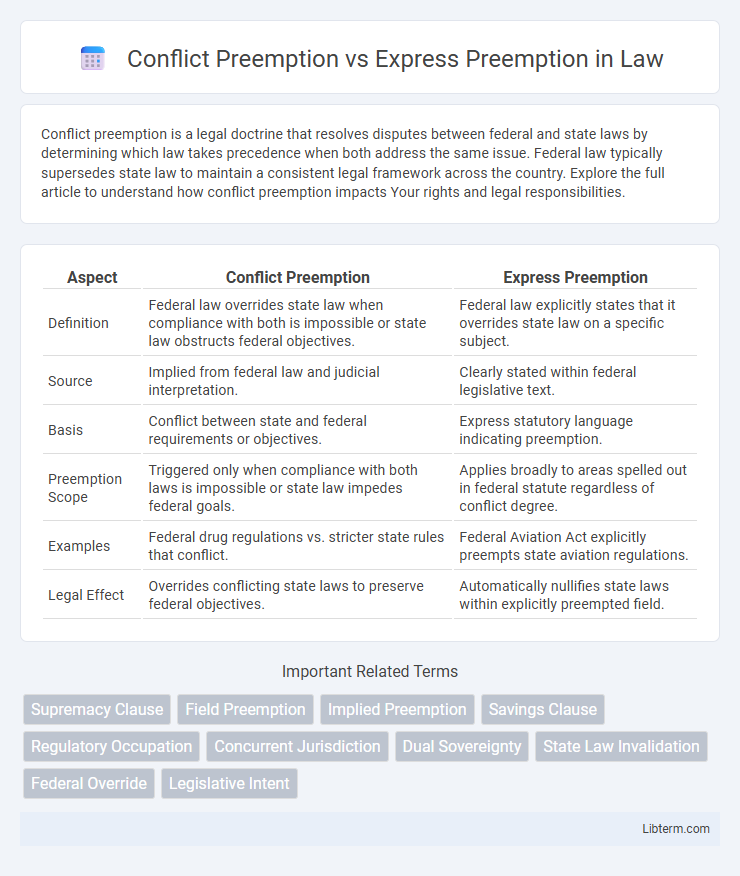Conflict preemption is a legal doctrine that resolves disputes between federal and state laws by determining which law takes precedence when both address the same issue. Federal law typically supersedes state law to maintain a consistent legal framework across the country. Explore the full article to understand how conflict preemption impacts Your rights and legal responsibilities.
Table of Comparison
| Aspect | Conflict Preemption | Express Preemption |
|---|---|---|
| Definition | Federal law overrides state law when compliance with both is impossible or state law obstructs federal objectives. | Federal law explicitly states that it overrides state law on a specific subject. |
| Source | Implied from federal law and judicial interpretation. | Clearly stated within federal legislative text. |
| Basis | Conflict between state and federal requirements or objectives. | Express statutory language indicating preemption. |
| Preemption Scope | Triggered only when compliance with both laws is impossible or state law impedes federal goals. | Applies broadly to areas spelled out in federal statute regardless of conflict degree. |
| Examples | Federal drug regulations vs. stricter state rules that conflict. | Federal Aviation Act explicitly preempts state aviation regulations. |
| Legal Effect | Overrides conflicting state laws to preserve federal objectives. | Automatically nullifies state laws within explicitly preempted field. |
Introduction to Federal Preemption in Law
Federal preemption arises from the Supremacy Clause of the U.S. Constitution, establishing that federal law overrides conflicting state legislation. Conflict preemption occurs when compliance with both federal and state laws is impossible or when state law obstructs federal objectives. Express preemption is explicitly stated within federal statutes, delineating the extent to which federal law supersedes state regulations.
Defining Conflict Preemption
Conflict Preemption occurs when compliance with both federal and state regulations is impossible, or when state law stands as an obstacle to achieving federal objectives. This form of preemption invalidates state rules that directly conflict with federal statutes or undermine federal goals. Defining Conflict Preemption centers on the irreconcilable clash between state and federal laws, necessitating federal law supremacy to maintain legal coherence.
Defining Express Preemption
Express preemption occurs when a federal statute explicitly states that it overrides state laws within its scope, providing clear legislative intent to prevent conflicting state regulation. Conflict preemption arises when state law stands as an obstacle to achieving the objectives of federal law, even without explicit language. Express preemption offers definite boundaries for regulatory authority, emphasizing the supremacy of federal statutes where expressly declared.
Key Differences Between Conflict and Express Preemption
Conflict preemption occurs when federal law conflicts with state law making it impossible to comply with both or when state law stands as an obstacle to federal objectives. Express preemption arises when a federal statute explicitly states that federal law overrides state law in a specific area. The key difference lies in express preemption's clear congressional intent versus conflict preemption's inference based on incompatibility or obstruction.
Legal Doctrines Underlying Each Preemption Type
Conflict preemption arises when state law stands as an obstacle to the accomplishment and execution of federal objectives, relying on the Supremacy Clause to invalidate conflicting state provisions. Express preemption occurs when a federal statute explicitly states that federal law overrides state law in certain areas, providing a clear legislative directive to preempt state regulation. The legal doctrine for conflict preemption centers on implied preemption based on federal intent and practical incompatibility, while express preemption depends strictly on statutory language indicating Congress's intent to occupy the regulatory field.
Landmark Supreme Court Cases on Preemption
The landmark Supreme Court case Rice v. Santa Fe Elevator Corp. established the principle of conflict preemption, where federal law overrides state law when they directly conflict or when state law obstructs federal objectives. In contrast, express preemption is illustrated by cases like Cipollone v. Liggett Group, where the Court enforced explicit congressional language in federal statutes that preempt state regulation. These cases clarify how the Court balances federal supremacy and state regulation boundaries through both implicit conflict and clearly stated express preemption doctrines.
How Courts Determine Conflict Preemption
Courts determine conflict preemption by analyzing whether state law stands as an obstacle to achieving federal objectives, assessing if compliance with both state and federal regulations is impossible, or if state law undermines federal purposes. They examine the explicit language of federal statutes and legislative intent to infer preemptive scope. Key factors include the degree of federal regulation in the area and whether state rules interfere with federal schemes or create barriers to uniform national policies.
Typical Scenarios for Express Preemption
Express preemption typically arises in federal statutes where Congress explicitly states its intent to override state laws, such as in the regulation of aviation safety or drug approval. In these scenarios, state laws conflicting with federal regulations are invalidated to maintain uniform national standards. Examples include federal laws that prevent states from imposing different labeling requirements on pharmaceuticals or varying safety standards for commercial airlines.
Implications for State and Federal Laws
Conflict preemption arises when state laws directly contradict federal statutes, rendering state regulations invalid to maintain federal law supremacy. Express preemption occurs when a federal law explicitly states that it overrides state legislation, providing clear guidance on jurisdictional boundaries. Both forms impact state authority by limiting states' ability to enact or enforce laws that interfere with federal policies, influencing regulatory consistency and legal predictability across jurisdictions.
Practical Examples Illustrating Each Preemption
Conflict preemption occurs when a state law directly contradicts a federal law, making compliance with both impossible, such as a state mandating a different labeling requirement than the FDA for pharmaceuticals. Express preemption arises when a federal statute explicitly states that federal law overrides state regulations, exemplified by the Federal Aviation Administration (FAA) prohibiting states from regulating aircraft safety standards. These examples highlight how conflict preemption deals with contradictory obligations, while express preemption relies on clear legislative language to assert federal supremacy.
Conflict Preemption Infographic

 libterm.com
libterm.com